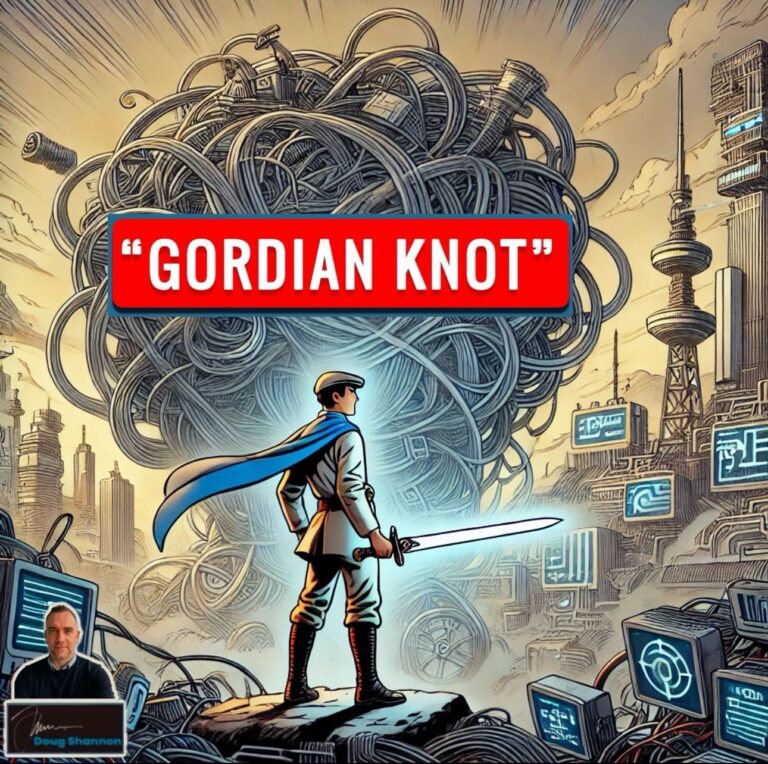𝐓𝐡𝐞 𝐆𝐨𝐫𝐝𝐢𝐚𝐧 𝐊𝐧𝐨𝐭 𝐨𝐟 𝐀𝐈: 𝐖𝐡𝐲 𝐖𝐞 𝐍𝐞𝐞𝐝 𝐚 𝐁𝐨𝐥𝐝 𝐂𝐮𝐭, 𝐍𝐨𝐭 𝐉𝐮𝐬𝐭 𝐌𝐨𝐫𝐞 𝐓𝐰𝐢𝐬𝐭𝐬
In ancient Phrygia, “now times know as Turkey, or Türkiye” there was a story about an intricate knot that bound an ox-cart to a post. Prophecy claimed that whoever untied it would rule Asia. Many tried, carefully pulling at loops and ends, but the knot was too complex. Then came Alexander the Great, who didn’t waste time unraveling it. Instead, he cut through the knot with his sword, solving the problem in a single stroke.
This isn’t just a historical anecdote, it’s a mirror of the AI challenges enterprises face today.
𝐓𝐡𝐞 𝐌𝐨𝐝𝐞𝐫𝐧 𝐆𝐨𝐫𝐝𝐢𝐚𝐧 𝐊𝐧𝐨𝐭: 𝐀𝐈 𝐢𝐧 𝐭𝐡𝐞 𝐄𝐧𝐭𝐞𝐫𝐩𝐫𝐢𝐬𝐞
Businesses today are tangled in a 𝐤𝐧𝐨𝐭𝐬 𝐨𝐟 𝐥𝐞𝐠𝐚𝐜𝐲 𝐬𝐲𝐬𝐭𝐞𝐦𝐬, 𝐟𝐫𝐚𝐠𝐦𝐞𝐧𝐭𝐞𝐝 𝐀𝐈 𝐭𝐨𝐨𝐥𝐬, 𝐚𝐧𝐝 𝐝𝐢𝐬𝐜𝐨𝐧𝐧𝐞𝐜𝐭𝐞𝐝 𝐚𝐮𝐭𝐨𝐦𝐚𝐭𝐢𝐨𝐧 𝐞𝐟𝐟𝐨𝐫𝐭𝐬. Many leaders believe they need to carefully “untie” these complexities, gradually integrating AI assistants, layering more automation onto old processes, and attempting to retrofit modern technology into outdated infrastructures.
But the problem isn’t how tightly wound these systems are, the problem is the assumption that they must be untangled at all.
𝐂𝐮𝐭𝐭𝐢𝐧𝐠 𝐭𝐡𝐞 𝐊𝐧𝐨𝐭: 𝐀 𝐌𝐮𝐥𝐭𝐢-𝐀𝐠𝐞𝐧𝐭 𝐅𝐮𝐭𝐮𝐫𝐞
Just like Alexander, enterprises must stop trying to incrementally fix legacy inefficiencies and instead take a fundamentally new approach:
🔹 𝐅𝐫𝐨𝐦 𝐀𝐬𝐬𝐢𝐬𝐭𝐚𝐧𝐭𝐬 𝐭𝐨 𝐀𝐠𝐞𝐧𝐭𝐬 – Instead of static chatbots and single-task AI assistants, enterprises need multi-agent AI frameworks that dynamically adapt, collaborate, and drive real outcomes.
🔹 𝐎𝐧𝐭𝐨𝐥𝐨𝐠𝐲 𝐎𝐯𝐞𝐫 𝐏𝐚𝐭𝐜𝐡𝐰𝐨𝐫𝐤 – Businesses must define structured knowledge frameworks that give AI systems context, rather than forcing disparate models to work together in a fragile patchwork.
🔹 𝐀𝐈 𝐚𝐬 𝐚 𝐒𝐲𝐬𝐭𝐞𝐦, 𝐍𝐨𝐭 𝐚 𝐓𝐨𝐨𝐥 – The future isn’t about adding more bots or isolated automations; it’s about building AI-driven architectures that rethink workflows from the ground up.
𝐓𝐡𝐞 𝐂𝐡𝐨𝐢𝐜𝐞: 𝐊𝐞𝐞𝐩 𝐔𝐧𝐭𝐚𝐧𝐠𝐥𝐢𝐧𝐠 𝐨𝐫 𝐒𝐭𝐚𝐫𝐭 𝐂𝐮𝐭𝐭𝐢𝐧𝐠?
Alexander understood that some problems aren’t solved by working within their constraints, they require a new way of thinking. The same is true for AI and enterprise automation.
𝐓𝐡𝐞 𝐪𝐮𝐞𝐬𝐭𝐢𝐨𝐧 𝐢𝐬: 𝐀𝐫𝐞 𝐰𝐞 𝐛𝐨𝐥𝐝 𝐞𝐧𝐨𝐮𝐠𝐡 𝐭𝐨 𝐫𝐞𝐭𝐡𝐢𝐧𝐤 𝐭𝐡𝐞 𝐬𝐲𝐬𝐭𝐞𝐦 𝐢𝐭𝐬𝐞𝐥𝐟?
#AI #himumanfirst #mindsetchange #FutureOfWork
Forbes Technology Council Gartner Peer Experiences InsightJam.com PEX Network Theia Institute VOCAL Council IgniteGTM Solutions Review
𝗡𝗼𝘁𝗶𝗰𝗲: The views within any of my posts, or newsletters are not those of my employer or the employers of any contributing experts. 𝗟𝗶𝗸𝗲 👍 this? feel free to reshare, repost, and join the conversation!



